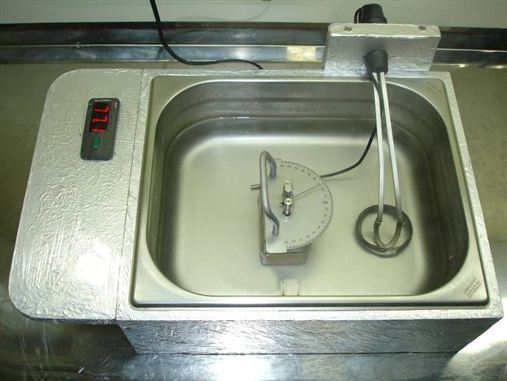Vol. 5 – Número 17 – 2012 Artigo original/Original article Página 28-35 Influência do modelo do bráquete no movimento ortodôntico de rotação: estudo comparativo Influence of the model of the bracket in the orthodontic movement of rotation: comparative study Jairo J. Benetti1 Maria Cristina Jimenez Pellegrin2 Celestino Nóbrega3 Márcio Rivero Gick4 Temístocles Uriarte Zucchi5 Sérgio Ricardo Jakob6 Resumo O objetivo do estudo foi comparar a eficiência e o desempenho de bráquetes frente ao movimento de rotação. O método utilizou bráquetes convencionais Ovation® (GAC, Bohemia, NY, USA) ligados por amarrilho metálico e por ligante elastomérico, bráquetes autoligantes interativos In-Ovation R® (GAC, Bohemia, NY, USA) e bráquetes autoligantes passivos Damon 2® (ORMCO, Orange, CA, USA). Para padronizar o experimento foi criado um simulador de movimento dentário rotacional, composto por três pinos metálicos, dois fixos e um móvel, imersos em cera, aos quais foram encaixados corpos de prova com os bráquetes. O pino móvel foi rotacionado 30 graus. A simulação da correção da rotação dentária foi realizada com o fio 0,016’’ NiTi e na sequência com o fio 0,018’’ NiTi. As amostras foram testadas individualmente com temperatura externa constante e de forma idêntica, repetindo 10 vezes para cada amostra, registrando a quantidade de rotação em relação ao tempo. Os resultados foram tratados, estatisticamente, através da análise de variância, utilizando delineamento em medidas repetidas, complementado pelo Teste de Comparações Múltiplas de Tukey ao nível de significância de 5%. Os resultados demonstram maior controle e eficiência na correção da rotação dentária através dos bráquetes autoligantes em comparação com os convencionais. Entre os autoligantes, o resultado foi melhor com o sistema interativo, sendo que nos bráquetes convencionais com ligante elastomérico obteve-se a menor correção angular, considerando o mesmo espaço de tempo. Os acessórios autoligantes mostram a grande vantagem de um sistema de baixo atrito e com excelente gerenciamento no controle do movimento. Descritores: Aparelho ortodôntico, movimentação dentária, rotação. Abstract This study compared brackets efficiency and performance regarding rotational movements. Therefore, conventional Ovation® (GAC, Bohemia, NY, USA), brackets with archwires attached by both elastomeric and metallic ligatures, interactive self ligating In-Ovation R® (GAC, Bohemia, NY, USA) and passive self ligating Damon 2® (ORMCO, Orange, CA, USA) were used. To standardize the experiment a simulator of rotational, composed dental movement was created for three metallic bolts, two fixtures and furniture, immersed in wax, which had been incased bodies of test with the different types of brackets. The mobile bolt was rotational 30 degrees. The simulation of the correction of the dental rotation was carried through initially with the wire 0,016’’ NiTi and in the sequence with the 0,018’’ wire NiTi. The samples had been tested individually with constant external temperature and of identical form, being that the tests had been repeated 10 times for each sample, with the amount of rotation in registered relation to the time. The harvested results had been dealt with statistical through the analysis variance using the delineation in repeated measures, complemented for the Test of Multiple Comparisons of Tukey to the level of significance of 5%. The results of the study demonstrate greater have controlled and efficiency in the correction of the dental rotation through brackets self ligating, in the comparison with the conventional. Between the self ligating, the result was better with the interactive system, being that in brackets conventional with elastomeric ligating it was gotten lesser angular correction, considering the same time space. These results demonstrated the advantages of a system that works due to friction control that brings a better control over the dental movement. Descriptors: Orthodontic appliances, dental movement, rotation. 1 Mestre em Ortodontia/Faculdade São Leopoldo Mandic. Pós-graduado na New York University. 2 Prof.ª Doutora do Programa de Pós-Graduação do CPO São Leopoldo Mandic. 3 Dr. em Ortodontia.Diretor do Programa Internacional de Ortodontia da New York University. 4 Ms. em Ortodontia/Faculdade São Leopoldo Mandic. 5 Ms. em Ortodontia/Faculdade São Leopoldo Mandic. 6 Dr. em Ortodontia. Coord. ;Prof. dos Cursos de Especialização em Ortodontia da UNIP/GO e EAP FUNORTE / GO.
Este conteúdo é restrito a membros do site. Se você é um usuário registrado, por favor faça o login. Novos usuários podem registrar-se abaixo.
LEIA MAIS

